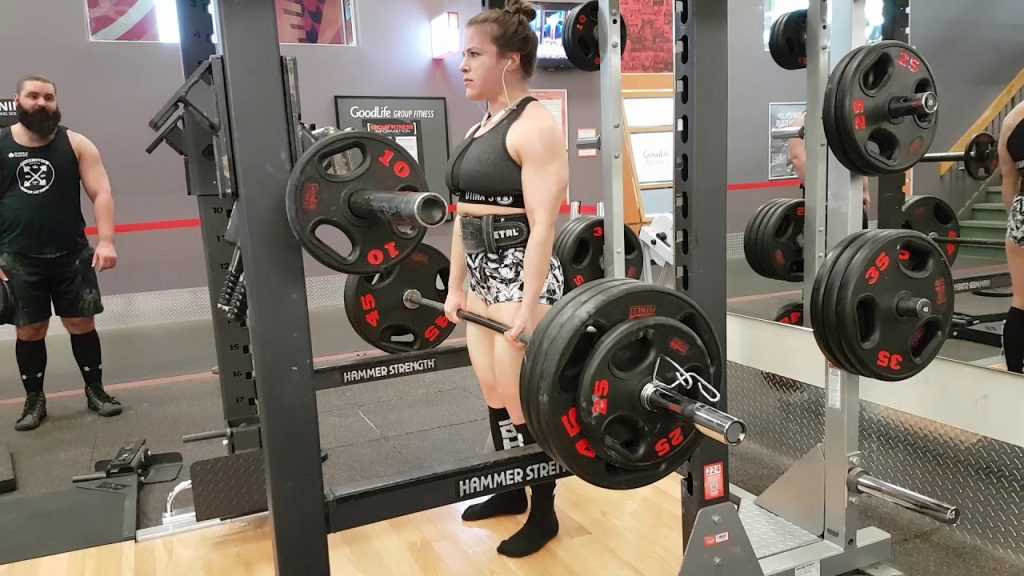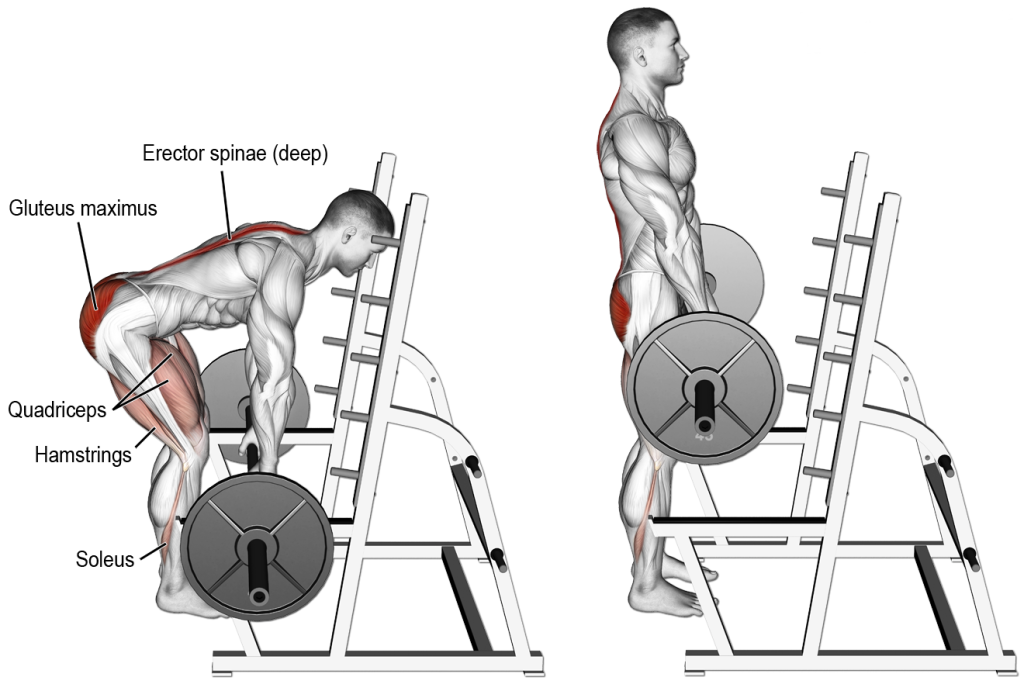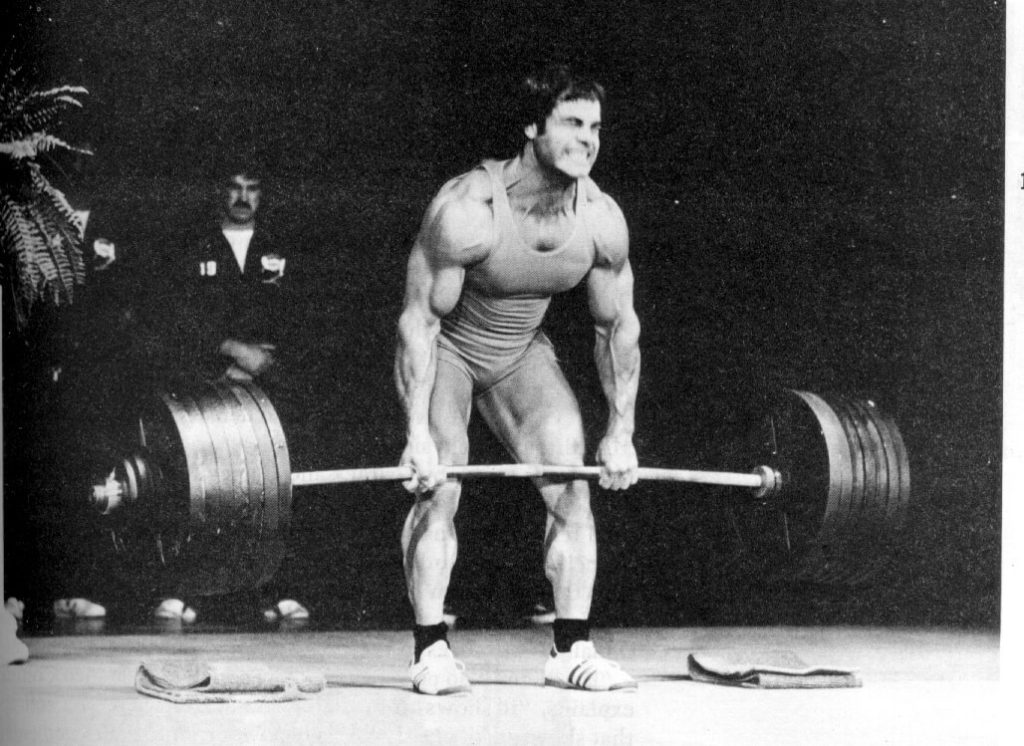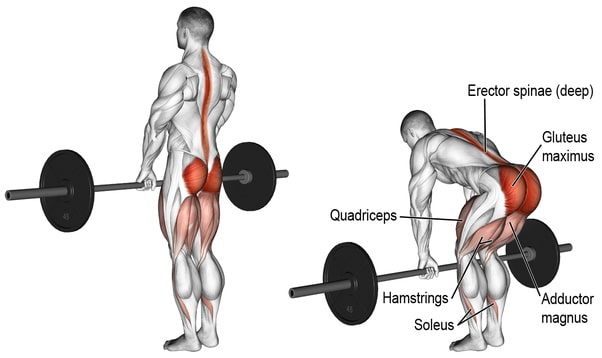Rack pulls and conventional deadlifts are both great muscle and strength builders but is one better than the other? In this article, we compare these two barbell exercises so you can decide which one to use.
Exercises don’t come much purer or more straightforward than deadlifts and their close relative, the rack pull. With both of these moves, you simply load up a heavy barbell, grab it with both hands, and use your legs and back to lift it up.
While rack pulls and conventional barbell deadlifts share many of the same benefits and even some of the same drawbacks, there are differences too. That means, for some exercisers, one may be more useful than the other.
So, which one should you do? Or should you incorporate both in your workouts? We’re here to help you decide!
Rack Pulls 101

Rack pulls are a variation of deadlifts. In simple terms, they involve starting your deadlift with the bar raised to around knee height by placing it in a power rack. This reduces your range of motion which means you should be able to lift more weight. As an added benefit, you don’t need to bend over as far to grab the bar, which means rack pulls require less mobility and flexibility than conventional and sumo deadlifts.
Powerlifters often use the rack pull as an assistance or accessory exercise to boost conventional deadlift performance. It’s also a good exercise for hypertrophy and building a wider, thicker back. Strongmen sometimes do a variation of the rack pull in competitions – the silver dollar deadlift. In this event, the bar is set at 18” above the ground, rather than 9”, which is the norm in powerlifting.
Muscles worked

Rack pulls are a compound exercise. That means it involves two or more joints and a whole host of muscles. The main muscles trained during rack pulls are:
- Hamstrings – rear of the thigh
- Gluteus maximus – bottom/butt muscles
- Erector spine – muscles on either side of your spine
- Quadriceps* – muscles on the front of the thigh
- Core muscles – deep muscles surrounding your internal organs
- Rhomboids and trapezius – muscles of the upper back
- Latissimus dorsi – side upper back muscles
- Deltoids – muscles of the shoulder
- Biceps and triceps – front and back of the upper arm
- Forearm flexors – gripping muscles
*The degree of quadriceps engagement depends on the height of the rack. The lower the bar, the more you’ll need to bend your knees, and the harder your quads will have to work. Starting with the bar above knee height means you won’t need to use your quads as much.
How to do rack pulls
- Place your barbell in a squat rack with the safety bars set to between mid-shin to lower-thigh height. Alternatively, you can place your barbell on boxes or blocks.
- Stand with your feet shoulder to hip-width apart, legs touching the bar.
- Lean forward and hold the bar with an overhand or mixed grip. Brace your abs, pull your shoulders back and down, and straighten your arms. Use lifting straps if required. Your knees should be slightly bent, with the degree of flexion determined by the height of the bar.
- Drive your feet into the floor and stand up, taking care not to lean back or bend your arms at the top of the rep, which could lead to injury.
- Push your hips back and lower the bar back down to the rack. Do not drop the bar as you could damage it.
- Reset your core and repeat.
Rack pulls – pros
Not sure if rack pulls are the right exercise for you? Consider these benefits:
Get stronger – the reduced range of motion means most exercisers can lift heavier weights with rack pulls than with conventional deadlifts. In theory, this could lead to more significant strength increases.
Improved grip strength – with the potential to hoist more weight, rack pulls could help you develop a stronger grip. That’s especially true if you do rack pulls using an overhand grip and without the benefit of lifting straps. Fat bar rack pulls are even better for increasing grip strength.
Build a more muscular back – lifting more weight means your trapezius, latissimus dorsi, rhomboids, and erector spinae are exposed to more muscle tension, which could trigger greater hypotrophy. Bodybuilders often do rack pulls as part of their back-building workouts.
Beat your conventional deadlift sticking points – if your deadlift tends to stall between knee height and lockout, rack pulls could help. They allow you to focus on the uppermost three-quarters of each rep. In time, this could eliminate your sticking point, allowing you to lift more weight for the full range of motion.
Less low back stress – compared to conventional deadlifts, doing rack pulls means you don’t have to bend over as far to grip the bar. Less forward flexion reduces lower back stress. Also, if you find it hard to get into a good set-up position when deadlifting off the floor, maybe because of tight hamstrings, you will probably find that rack pulls are more forgiving.
Focus more on your posterior chain – rack pulls tend to involve less knee flexion and extension, with more of the movement coming from your hips. Like Romanian deadlifts, which rack pulls somewhat replicate, this means you can focus more on your glutes, hamstrings, and lower back muscles, which are collectively called the posterior chain.
Rack pulls – cons
Like every exercise, there are a few cons to doing rack pulls, too:
You’ll need a rack – one of the great things about conventional deadlifts is how straightforward they are. All you need is a barbell and some plates. Switching to rack pulls means you’ll need some extra equipment, namely a power rack or adjustable squat rack.
Barbell wear and tear – good quality deadlifting bars are designed to flex in the middle but be stiffer toward the ends. Doing rack pulls with a deadlift bar means the weight is focused on the more rigid ends, which could cause damage. That’s especially true if you drop the bar between reps. You could end up ruining a deadlift bar with rack pulls. Deadlifts from blocks are better for your barbell.
Lift more weight – being able to lift more weight is a double-edged sword. On the one hand, it means you could get stronger and build more muscle. On the other, it means you may try and lift too much weight for your abilities and end up injured. Just because you can go heavier on rack pulls than conventional deadlifts doesn’t mean you should. Increase your weights gradually to avoid injuries, both acute and chronic.
Less functional – lifting heavy objects off the floor is something most people need to do from time to time. The lower the object is to the floor, the harder it is to lift. Rack pulls involve lifting a weight that’s well above the floor. As such, the rack pull is potentially less functional than conventional deadlifts, where the bar is usually about nine inches above floor level.
Not a recognized test of strength – the deadlift is one of the exercises contested in powerlifting. The height of the bar is always the same (nine inches above the floor), so those performances are standardized, and one lifter’s efforts can easily be compared to another.
In contrast, rack pulls are done from a range of heights, usually determined by the lifter. So, while rack pulls are valuable for developing strength, they are less helpful for measuring it. The exception to this rule is the silver dollar deadlift, where the bar is set to 18” above the floor. This is a lift that often features in strongman competitions.
Conventional Deadlifts 101

The conventional deadlift is a classic barbell exercise. Used to develop and test full-body strength, the conventional deadlift is popular with bodybuilders and is an integral part of powerlifting. While some powerlifters prefer the sumo deadlift, the conventional variation is arguably the most widely performed version. Bodybuilders tend to do deadlifts to build a wider, thicker back.
In simple terms, the deadlift involves lifting a weight off the floor. Each rep starts with a stationary weight – a “dead” weight, which is where this exercise gets its name. The conventional deadlift also teaches you how to safely lift heavy objects off the floor, i.e., using your legs and without rounding your lower back.
Almost every exerciser should do some form of deadlifts; they’re THAT important. In Victorian times, the deadlift was called the health lift, which illustrates just how beneficial this exercise can be.
Muscles worked

Conventional deadlifts involve the same muscles as rack pulls. However, you’ll need to use your quads more as you’ll be starting each rep from the floor, which involves more knee flexion.
The main muscles used during conventional deadlifts are:
- Gastrocnemius and soleus – calf muscles
- Hamstrings – rear of the thigh
- Quadriceps – front of the thigh
- Gluteus maximus – bottom/butt muscles
- Erector spine – muscles on either side of your spine
- Core muscles – deep muscles surrounding your internal organs
- Rhomboids and trapezius – muscles of the upper back
- Latissimus dorsi – side upper back muscles
- Deltoids – muscles of the shoulder
- Biceps and triceps – front and back of the upper arm
- Forearm flexors – gripping muscles
Conventional deadlifts are generally done using a barbell but can also be done with dumbbells.
How to do conventional deadlifts:
- Set your barbell, so it’s nine inches above the floor. Using bumper plates usually does this automatically.
- Stand with your toes under the bar, feet about hip to shoulder-width apart.
- Reach down and grip the bar with an overhand or mixed grip.
- Straighten your arms, pull your shoulders down and back, and brace your abs. Your hips should be below your shoulders, and your lower back slightly arched.
- Without bending your arms or rounding your lower back, drive your feet into the floor and stand up.
- Do not lean back at the top or attempt to bend your elbows, as this can cause serious injury.
- Push your hips back, bend your knees, and lower the bar back to the floor.
- Let the weight settle for a second or two, and then repeat. Do not bounce the bar off the floor.
Conventional Deadlift Pros
There are several reasons that conventional deadlifts deserve a place in your workouts, including:
Build full-body training effect – the deadlift works virtually every muscle in your body. There aren’t many exercises that involve more muscles at the same time. As such, conventional deadlifts are a very time-efficient exercise. Combine them with something like bench presses, dips, or overhead presses, and you really can train your entire body with just two exercises.
Very functional – conventional deadlifts involve bending down and lifting a weight off the floor. This is a task most people do fairly regularly. As such, conventional deadlifts can make some of the tasks of everyday living a little easier, such as picking up your kids or carrying heavy grocery bags.
Accessible – all you need to do conventional deadlifts is a barbell and some weight plates. You can also do deadlifts using dumbbells, or even a heavy rock, backpack, or similar.
Build a bigger back – Lat pulldowns, pull-ups, and bent-over rows are all effective back exercises, but they mainly focus on your lats. Conventional deadlifts work every muscle on the back of your body, from the nape of your neck to your heels. If you want a big, powerful back, conventional deadlifts will help.
Conventional Deadlifts Cons
Like every exercise, there are drawbacks to doing conventional deadlifts, too:
Risk of back injury – because they start from the floor, conventional deadlifts put a lot of stress on your lower back. This risk increases exponentially if you round your lumbar spine. Tall lifters, people with poor hamstring flexibility, and those with a weak core are prone to rounding their lower backs during conventional deadlifts. Starting each rep with the bar nearer to knee height takes a lot of stress off the lower back, making rack pulls potentially safer.
Rack Pulls vs. Conventional Deadlifts
So, now that you know a little more about rack pulls and conventional deadlifts, let’s judge these exercises by a few different criteria:
Strength
Most people can rack pull more than they can deadlift from the floor. This means that rack pulls have the potential to increase strength more than conventional deadlifts. However, strength increases are specific to the range of motion you’re working in. So, while heavy rack pulls will make you a better rack puller, that may not have a significant impact on other feats of strength.
If you want to be strong from the floor and not just knee height, conventional deadlifts are your best choice. But, if you want to increase your strength nearer to lockout, rack pulls could be better.
Hypertrophy
You can use rack pulls and conventional deadlifts to build muscle. However, where rack pulls emphasize your upper body, conventional deadlifts involve more lower-body muscle engagement.
Because rack pulls usually allow you to lift more weight, they could be better for building muscle mass, especially in the upper back. But, if you also want to develop more muscular hamstrings and glutes, the conventional deadlift is probably the best option.
Safety
Rack pulls and conventional deadlifts can both be performed safely. If you are unable to complete a rep, you can simply put the bar down, and won’t get pinned under a heavy load.
However, because conventional deadlifts start from the floor, the need for good flexibility is higher than for rack pulls. Rack pulls involve less forward flexion, so the risk of lower back injury is lower. That said, either exercise done incorrectly could cause severe damage to the lumbar spine, spinous ligaments, intervertebral discs, and erector spinae muscles.
Finally, lifters can often use more weight for rack pulls than conventional deadlifts, so there is a danger of overestimating rack pull strength, which could cause injury. That said, this problem is easy to avoid by easing into rack pulls, and not going too heavy too soon.
Ease of Learning
Conventional deadlifts involve a fairly commonplace, natural movement pattern. Most people do something akin to a deadlift whenever they bend down to pick something up from the floor.
That said, because rack pulls involve a shorter range of motion and less forward flexion, getting into the correct starting position is often easier and requires less flexibility.
Lifters can use rack pulls to get the hang of hip hinging without having to try and get into such a low starting position. Then, as they get used to the exercise, they can gradually lower the height of the bar until, eventually, they’re deadlifting from the floor.
Because of this, many exercisers will find rack pulls easier to learn than conventional deadlifts.
Variety
One of the best ways to avoid progress plateaus is to change your workout from time to time and use variations of your main exercises. In many cases, simply altering the width of your grip or the angle of your bench is all that’s needed to avoid workout ruts.
There are lots of ways to modify conventional deadlifts to maintain progress and ward off boredom. Good options include:
- Deficit deadlifts – standing on 4 to 6” platform to increase range of motion
- Deadlifts with chains or bands – to increase load as you approach lockout
- Paused deadlifts – pause with the bar at knee height for 2-5 seconds
- Speed deadlifts – use 50% of your 1RM and lift the bar as fast as you can
Plus, there are lots of deadlift variations you can do:
- Deficit deadlift
- Dumbbell deadlift
- Kettlebell deadlift
- Partial deadlift
- Paused deadlift
- Reeves deadlift
- Romanian deadlift
- Single-leg deadlift
- Snatch grip deadlift
- Stiff leg deadlift
- Suitcase deadlift
- Trap bar deadlift
In contrast, rack pulls are already a variation of deadlifts, and there aren’t many ways to change this exercise. Your options are mostly limited to:
- Smith machine rack pull
- Snatch grip rack pull
- Rack pull with bands or chains
Functionality
If you need to lift a heavy object, invariably, it is resting on the floor. Subsequently, you’ll need to squat down low to grab it, just as you do with conventional deadlifts. You’re much less likely to come across a heavy load that’s conveniently situated at knee height.
While rack pulls are a useful exercise, the conventional deadlift is probably best for developing the type of strength you can use outside the gym.
Wrapping Up
In many ways, comparing rack pulls with conventional deadlifts is unnecessary. They’re two similar but different exercises, and each one has benefits and drawbacks.
Where conventional deadlifts are more of a full-body exercise, rack pulls emphasize your upper body more. Rack pulls are often easier to learn, and you don’t need to be as flexible to get into the correct starting position. But, conventional deadlifts are more natural and functional.
You don’t even need to choose between them; you can do both! That way, you can enjoy all the benefits they offer. For example, you could start your workout with conventional deadlifts and then do rack pulls after, using them as an accessory exercise.
That said, if one exercise suits you better than the other, choose the one you prefer. So long as you get the results you want, it doesn’t matter what tools you use to achieve your goals.